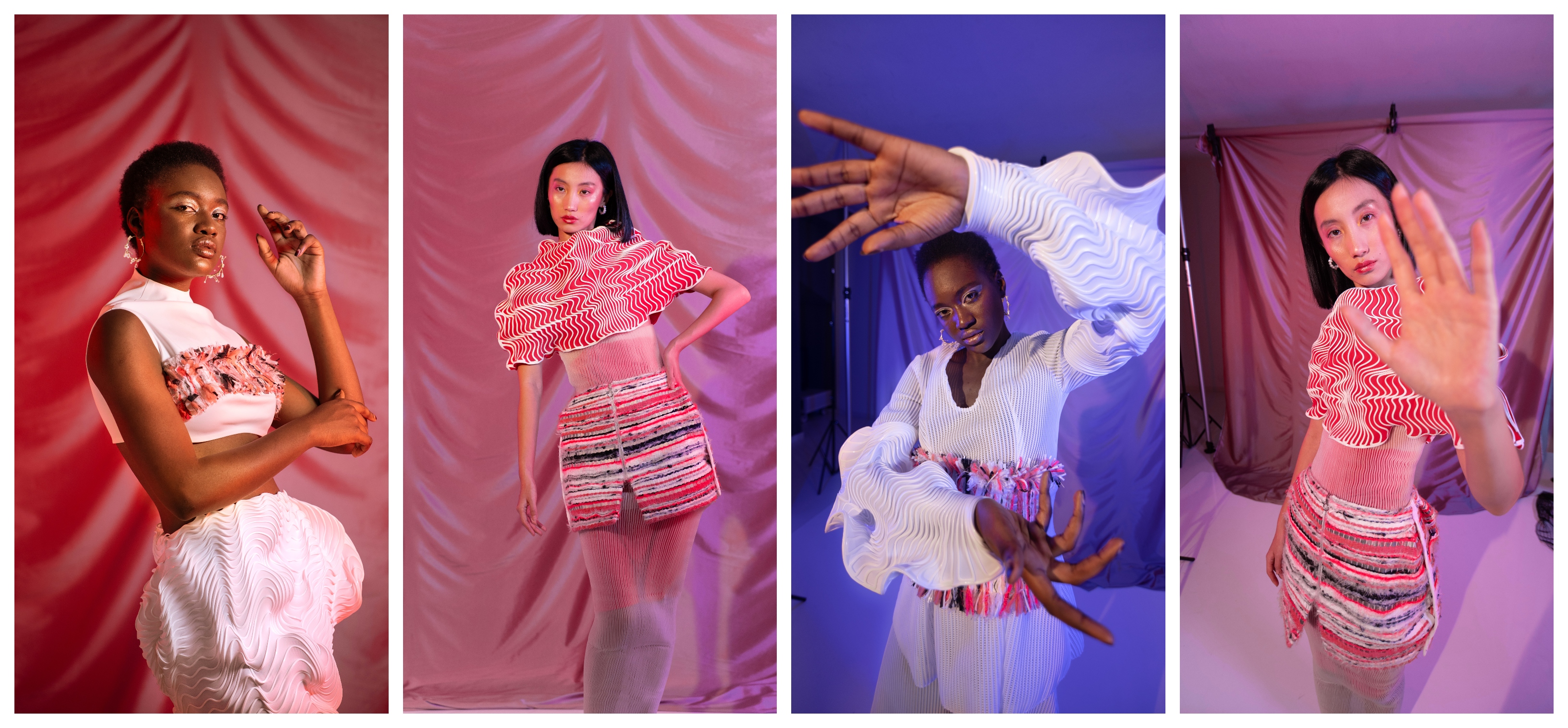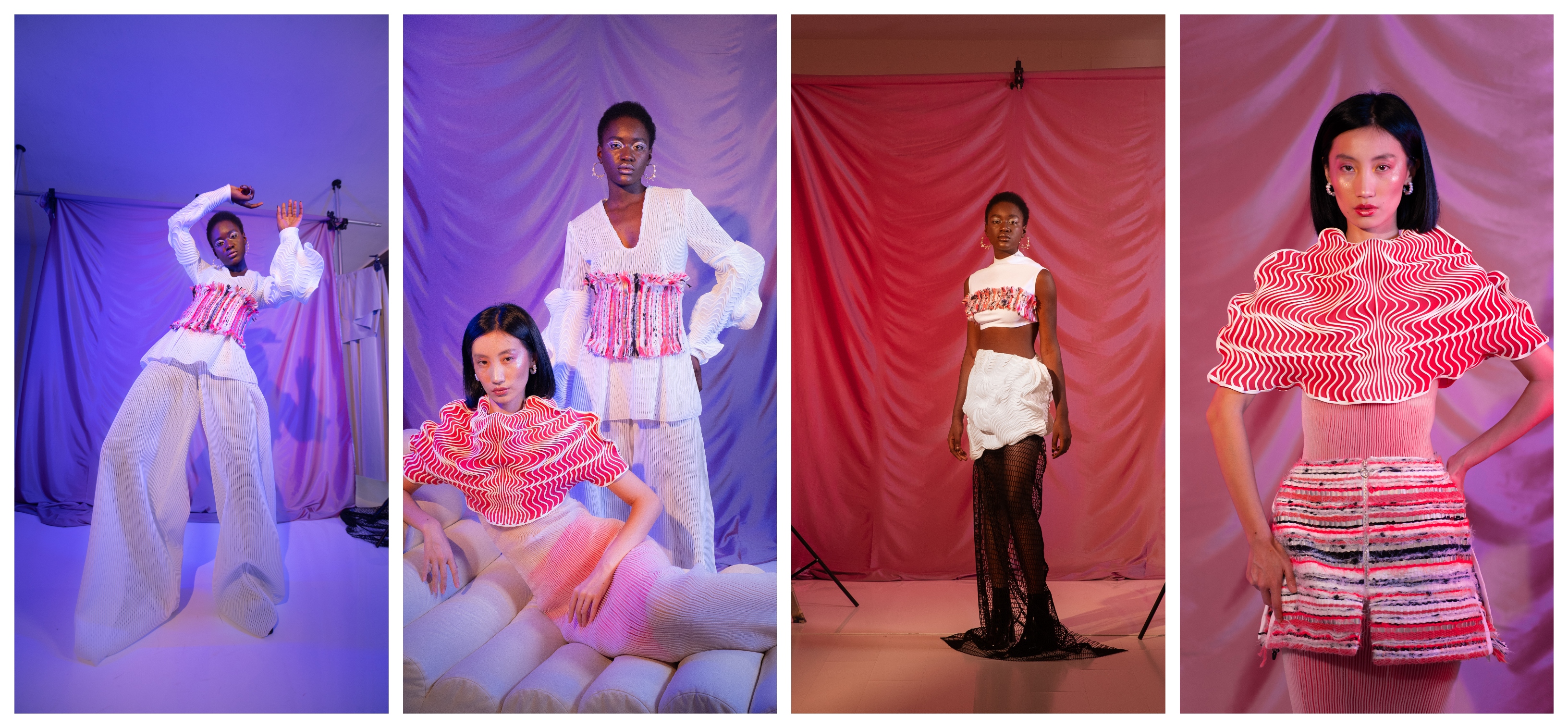Milan-based fashion designer Chiara Giusti has collaborated with Superforma Fablab, a digital manufacturing laboratory specializing in 3D printing, to create a 3D printed clothing line called TECHNĒ. As part of her final university project at Politecnico di Milano.
Giusti used Superforma’s Delta WASP 3MT Fused Deposition Modeling (FDM) printer to deposit Thermoplastic polyurethane (TPU) at high temperatures directly onto stretched textiles to create complex three-dimensional textures and geometries.
Giusti said: “I definitely believe that 3D printed fabrics could enter the global fashion market soon, but designers should combine their experience with the knowledge of scientists and engineers to further explore this sector, improving and stabilizing techniques and machines to obtain reliable, ergonomic products for the end-user.”
“The presence of a textile component constituting the base on which the printing machines fabricate is probably the best way today to help a gradual approach of global users towards 3D printed garments.”
TECHNĒ, FDM printers, and sustainability
To create TECHNĒ, Giusti studied how 3D printing is used with tension-activated textiles in-depth. Giusti’s main aim was to produce comfortable yet fashionable clothes where 3D printing played a structural and decorative role. Previously, 3D printed materials have been more rigid than most fabrics used in clothing, which is why Giusti used FDM machines to print directly onto apparel to make the clothes comfortable to wear.
“The combination of polymeric structures and fabric takes the best of both materials, allowing customization and the experimentation of new textures while ensuring comfort.” Giusti said, “3D printing on tension-activated textiles does not just mean using textiles as a substrate: 2D geometries are printed on fabrics in tension on the printing plate and, when released, the textiles achieve complex 3D volumes. This means that this specific technique guarantees wearability, soft-touch, breathability, and, most importantly, structure.”
Additionally, Giusti studied a range of materials and techniques to implement sustainable methods. She believes 3D printed fashion involving machines and craftsmanship can attract a consumer base with a conscious approach to style.
She added: “In a moment when everything is carelessly duplicated and synthesized, the combined work of mind, hands, and machines could generate a new fashion system.”

Giusti chose to 3D print garments overstretched textiles because the material does not require the same amount of cuts, seams, and darts as everyday clothing, which minimizes waste. The garments’ production process is swift with low energy and material consumption, as only one layer has to be deposited on the fabric for it to work. Giusti applied zero-waste techniques to her designs, using 3D printing prototype waste to hand-weave textiles with artisans’ help.
“Living and working within the area of Milan, a territory that is extremely rich in traditions and knowledge, it was natural to try to integrate the concept of innovation in this context, creating a network of professionals with digital skills, industrial expertise, and craftsmanship,” Giusti added. “That’s why I also approached textile companies Eurojersey and Gaetano Rossini, and hand-weaver Lidia Miotto.”
The collaboration with SuperForma and Coim
To bring TECHNĒ to life, Giusti experimented with several materials ranging from FilaFlex Thermoplastic elastomers (TPE) to Polylactic Acid (PLA). By collaborating with international polymeric materials production group leader Coim, Giusti selected Laripur TPU. She said: “The smooth effect of this 3D printed TPU perfectly suited the collection’s high performance, comfortable Sensitive Eurojersey fabrics.”
In the end, Laripur TPU was used because it is a recyclable plastic with a chemical structure that can manipulate materials into being soft and rigid, as well as influencing their appearance to be transparent, colored, or smooth.
Furthermore, SuperForma’s Delta WASP 3MT FDM machine helped Giusti fine-tune the printing parameters and experiment with different materials that lead to creating the final clothing line. Giusti added: “It was CEO and founder Mattia Ciurnelli of SuperForma who followed the progress of the experimentation and helped me to manage the available technologies with his competence in digital fabrication.”
Superforma is part of the international WASPHub network promoted by Italian 3D printer manufacturer WASP, a collaborative hub for manufacturing projects. Aside from its work with TECHNĒ, WASP has worked on other large-scale structures, such as partnering with the Rossana Orlandi gallery in Milan to showcase the Gaia, a 3D printed eco-house created with sustainable materials.

The application of additive manufacturing in fashion
Giusti believes her creativity strived from her knowledge in pattern making, which then influenced her ability to question, analyze, and rethink it throughout the study of the manufacturing process and experimentation with FDM printing machines. TECHNĒ was created with the ambition to combine form and function in 3D printed clothes. Giusti said: “Usually, 3D printing is used to create showpieces, sculptural structures, and even when printing materials and fabrics merge, additive manufacturing has a mainly decorative/ornamental role.”
Esteemed fashion designer Iris van Herpen, known for her occasional ‘decorative/ornamental’ application of 3D printing in her designs, debuted her 3D printed ‘face jewelry’ at Paris Fashion Week 2019. The collection entitled ‘Cellchemy’ was created by 3D scanning each model’s face to map out a shape highlighting shifts in density and contours of their faces. The final result was a series of lace-like masks created by a high-resolution multi-material printer.
In the same year, for the Met Gala, fashion designer Zac Posen teamed up with GE Additive and Protolabs to make celebrities like Jourdan Dunn a 3D printed gown. The dress was made from 21 individually 3D printed petals to allude to the idea that the garments are frozen in time. Underneath, a custom-made metal frame was used to hold each petal in place.
Giusti has also shared her admiration for the 3D printer manufacturer Stratasys and hopes to collaborate with the firm in the future. This year, Stratasys worked with fashion designer Ganit Goldstein to create a Japanese-style kimono using direct-to-textile multi-color 3D printing. Stratasys applied its PolyJet Technology in this project to showcase what 3D printing technology and comfort could look like to its global consumer base.
Check us out on Twitter and Facebook for more updates! Don’t forget to subscribe to the 3D Printing Industry newsletter to keep up-to-date with the latest 3D printing news.
Are you looking for a job in the additive manufacturing industry? Visit 3D Printing Jobs for a selection of roles in the additive manufacturing industry.
Feature image shows a model wearing Giusti’s collection called TECHNĒ. Photo via Pietro Agostini.


